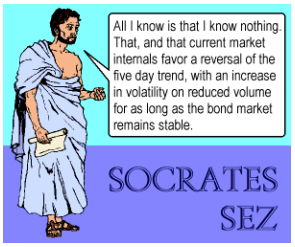The Wall Street Journal warned in early May that “Nearly everyone agrees the bond market will take a hit when the Federal Reserve starts raising interest rates, perhaps as early as next month.” The Fed did in fact raise the target federal funds rate from 1.00 percent to 1.25 percent on June 30, but the bond market did not take a hit, instead it rose that day, sending the yield on the ten year Treasury note (which moves in the opposite direction of bond prices) down to 4.59 percent, roughly 0.20 percent lower than its level when the Wall Street Journal article appeared. As of August 20th bonds had risen further, dropping the yield to 4.23 percent.
If the Fed’s move was a virtual certainty, why should market participants have been expected to wait until June 30th to take action as the article implied? That widely anticipated move was reflected in prices before the article appeared, and long before the Fed meeting. The subsequent rise in bond prices on June 30th was a reflection of whatever new developments were coming to light on that day; the Fed’s increase was a foregone conclusion to the market.
Unfortunately there is no shortage of brokers and other money managers with a knack for telling compelling tales about what the market, or a security, is about to do. Their claims are cleverly pitched and sound credible. The typical “talking head” is an entertainer, whose talent lies not in prognosticating but in making old, usually factual, news appear to be revelatory. These pundits invariably fail to explain why that information should not already have impacted the market.
We do not claim to compete with these showmen. We admit that our approach to investing is about as riveting as watching paint dry. For example, with regard to our approach to selecting large-cap value stocks, we do our very best to ignore all the news affecting the stocks in our high-yield Dow model, unless it pertains to a change in the dividend or the composition in the 30 stocks that comprise the Dow. Our mission is simple: to provide sound, low-cost investment education and advice to our readers and our advisory clients.

Also in This Issue:
What to Know About Municipal Bonds
Indexed Annuities: Too Good To Be True
Interest Rates and the Housing Boom
Changes in the Vanguard Short-Term Corporate Fund
The High-Yield Dow Investment Strategy
Recent Market Statistics
The Dow-Jones Industrials Ranked by Yield
To access the full article, please login or subscribe below.
Already a Subscriber?
Log in now
Subscribe Today
Get full access to the Investment Guide Monthly.
Print + Digital Subscription – $59/YearIncludes 12 Print and Digital Issues
Print + Digital Subscription – $108/2 Years
Includes 24 Print and Digital Issues
Digital Subscription – $49/Year
Includes 12 Issues
Digital Subscription – $98/2 Years
Includes 24 Issues

